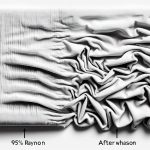To pre-wash fabric and avoid shrinkage before sewing, start by using cold water with a gentle detergent. Wash delicate fabrics on a gentle cycle and always follow the care instructions. Air dry whenever possible to maintain fabric integrity. For fabrics like cotton, linen, and rayon, it’s essential to check for defects post-wash, as well. By doing this, you’ll guarantee your projects come out just right. There’s more to discover about effective pre-washing techniques.
Table of Contents
Key Takeaways
- Always use cold water and a gentle cycle to prevent shrinkage during the pre-washing process.
- Check fabric care labels for specific washing instructions to ensure proper treatment.
- Add a mild detergent to clean the fabric without damaging its fibers.
- Air dry the fabric whenever possible to maintain its integrity and prevent further shrinkage.
- Inspect the fabric after washing for any defects or loose threads before cutting.
Reasons for Pre-Washing Fabric
When you pre-wash fabric, you’re not just following a trend; you’re guaranteeing your finished project looks its best.
Pre-washing helps remove any chemicals or sizing that could affect your fabric’s texture and color. It also allows you to identify any flaws, like uneven dyeing or defects, before you start sewing.
By washing your fabric first, you’re reducing the risk of shrinkage after your garment is complete. This means your measurements will stay true, and your project will fit as intended.
Additionally, pre-washing helps your fabric relax, making it easier to work with.
Ultimately, taking this extra step guarantees your finished piece looks polished and professional, giving you confidence in your sewing skills.
Fabrics That Require Pre-Washing
Certain fabrics absolutely need pre-washing to guarantee your sewing project turns out just right.
Not only do these materials shrink, but they can also bleed or change texture after the first wash.
To make sure your finished product looks and fits as intended, consider pre-washing the following fabrics:
- Cotton: This fabric often shrinks considerably, especially if it’s not treated.
- Linen: Known for its tendency to wrinkle, linen also shrinks when first washed.
- Rayon: This fabric can bleed color and shrink, so pre-washing is essential to maintain the vibrant look.
Pre-Washing Techniques for Different Fabrics
When it comes to pre-washing your fabric, different materials require specific techniques.
You’ll want to use cold water and a gentle cycle for delicate fabrics to prevent damage.
Understanding the right drying methods will also help maintain your fabric’s quality and guarantee it’s ready for sewing.
Cold Water Washing
While you might be tempted to toss all your fabrics into a hot wash, cold water washing is often the better choice for pre-washing.
It helps prevent shrinkage and fading, ensuring your fabric stays vibrant and true to size.
Here are three key benefits of cold water washing:
- Preserves Fabric Integrity: Cold water is gentler on fibers, reducing wear and tear.
- Color Retention: It minimizes color bleeding, keeping your fabrics looking fresh and new.
- Energy Efficient: Washing in cold water saves energy, making it an eco-friendly choice.
Gentle Cycle Recommendations
After washing your fabric in cold water, the next step is to contemplate how to treat it in the washing machine.
For delicate fabrics like silk and chiffon, use the gentle cycle to minimize agitation. This helps prevent damage while still allowing for effective cleaning.
For medium-weight cottons, the gentle cycle is also a smart choice, as it helps maintain the fabric’s integrity while removing any sizing or finish.
If you’re working with knits, opt for the gentle cycle to avoid stretching and distortion.
Always check the care label before washing, as it can provide specific recommendations.
Drying Methods Explained
To guarantee your fabric retains its quality after washing, how you dry it’s just as important as how you wash it.
Different fabrics require specific drying methods to prevent shrinkage and damage. Here are three effective techniques:
- Air Drying: Hang your fabric in a well-ventilated area to preserve its shape and texture. This method is gentle and reduces the risk of shrinkage.
- Tumble Dry on Low: If your fabric allows for machine drying, use a low heat setting. This minimizes the chances of overheating, which can cause shrinkage.
- Flat Drying: For delicate fabrics, lay them flat on a clean, dry surface. This helps maintain their structural integrity while avoiding unnecessary stretching.
Choose the right method for your fabric type to guarantee the best results!
Removing Chemicals and Excess Dye
Before you start sewing, it’s essential to remove chemicals and excess dye from your fabric, ensuring a safe and vibrant final product. Many fabrics contain residues from manufacturing processes, and pre-washing helps eliminate these harmful substances. Here’s a quick guide to help you:
| Method | Purpose | Tips |
|---|---|---|
| Soak in cold water | Remove excess dye | Use a mild detergent |
| Rinse thoroughly | Eliminate chemicals | Do this several times |
| Air dry | Prevent dye transfer | Avoid direct sunlight |
| Use vinegar soak | Set colors | 1 part vinegar to 3 parts water |
| Wash with like colors | Prevent color bleeding | Use cold water for washing |
Following these steps will keep your fabric safe and ready for your sewing project!
Preventing Fabric Distortion During Pre-Washing
While pre-washing fabric is essential for removing chemicals and excess dye, you’ll want to take steps to prevent distortion that can affect your final project.
Here are three tips to keep your fabric looking its best:
- Wash on a Gentle Cycle: Use a gentle cycle to minimize agitation, which can stretch or distort the fabric fibers.
- Avoid High Heat: If you’re using a dryer, choose a low heat setting. High heat can cause fabrics to shrink unevenly and lose their shape.
- Hang Dry When Possible: For delicate fabrics, consider air drying. This method helps maintain the original structure and prevents distortion caused by tumbling.
Specific Fabrics That Benefit From Pre-Washing
Pre-washing certain fabrics not only helps remove chemicals and excess dye but also assures they perform well in your sewing projects.
Cotton is a prime example; it tends to shrink, so pre-washing assures your final piece fits perfectly. Linen also benefits greatly, as it can soften and become more pliable once washed.
If you’re working with rayon or silk, pre-washing can help prevent unexpected shrinkage and maintain drape. Additionally, synthetic fabrics like polyester may hold onto chemicals, making pre-washing crucial for a soft finish.
Even blends, like cotton-polyester, can experience shrinkage, so it’s best to wash them beforehand. By pre-washing these fabrics, you’ll set yourself up for success in your sewing endeavors.
Tips for Effective Pre-Washing
To get the best results from pre-washing your fabric, start by checking the care instructions on the label. This will guide you on the right temperature and washing method.
Here are some tips to guarantee effective pre-washing:
- Use cold water: Cold water helps prevent shrinkage and fading, making it a safer choice for most fabrics.
- Add a mild detergent: A gentle detergent cleans without damaging fibers, guaranteeing your fabric stays in good shape.
- Air dry when possible: Instead of using a dryer, hang your fabric to dry. This further reduces the risk of shrinkage and maintains the fabric’s integrity.
Final Considerations for Pre-Washing Fabric
When you’re preparing to sew, considering the final steps of pre-washing fabric can make a significant difference in your project.
First, always check the fabric content and care instructions; this’ll help you choose the right washing method. Use the same settings you plan to use for future laundering.
After washing, inspect the fabric for any remaining dust or loose threads, and trim as necessary. Don’t forget to press your fabric before cutting; it’ll make measuring and cutting easier.
Finally, store your pre-washed fabric properly to keep it wrinkle-free and ready for your project.
Taking these steps guarantees that your fabric maintains its quality and behaves as expected during the sewing process, preventing unwanted surprises later on.
Frequently Asked Questions
Can I Pre-Wash Fabric in Hot Water Instead of Cold?
Yes, you can pre-wash fabric in hot water, but keep in mind it might shrink more than in cold. Always check the fabric care instructions first to avoid damaging your material during the process.
How Often Should I Pre-Wash Fabric Before Sewing?
Did you know that up to 10% of fabrics shrink after washing? You should pre-wash fabric each time you sew with new materials to guarantee consistent sizing, color integrity, and better handling during your project.
Is It Necessary to Pre-Wash Fabric Blends?
You should definitely pre-wash fabric blends. Even though they might not shrink as much as pure fabrics, pre-washing helps remove chemicals and dirt, ensuring your final project looks great and lasts longer.
Can I Use a Washing Machine for Pre-Washing?
Yes, you can use a washing machine for pre-washing. Just choose a gentle cycle and cold water to prevent damage. Make sure to follow care instructions for your specific fabric to maintain its quality.
What Should I Do if Fabric Shrinks After Pre-Washing?
If your fabric shrinks after pre-washing, don’t panic! You can try stretching it gently while damp, but if it’s a disaster, you might need to embrace creative solutions like adding a contrasting fabric for flair!
- Why Do My Linen Clothes Sometimes Develop Pills? - June 11, 2025
- How to Remove Pilling From Chenille Fabric Without Snagging It? - June 11, 2025
- What’s the Best Way to Store Clothes to Minimize Pilling Risks? - June 11, 2025





